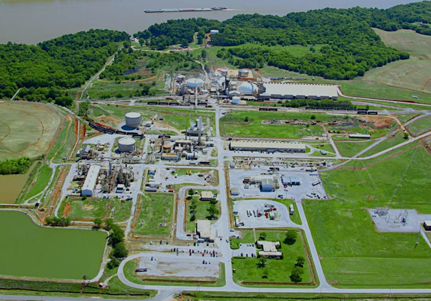For companies whose success depends on low-cost natural gas, finding ways to mitigate gas price risk is critical. Using financial hedges is one way; another (though far less common) is acquiring working interests in gas production assets—that is, buying a physical hedge. Florida Power & Light, which consumes more gas than any other US electric utility, is getting into the act. But others—including a leading fertilizer manufacturer and a big steel maker—helped pioneer the approach. In this episode of our series on major gas consumers buying gas production assets, we look at how these earlier efforts are panning out, and how the flexibility built into the deals is paying off.
As we said in our series opener, Sweet Gas o’ Mine—Big Gas Consumers Seeking Stakes in Gas Production, US gas production is rising and the forward gas curve suggests prices will remain moderate. But occasional gas price volatility remains a near-certainty, and increasing demand for gas (new petrochemical capacity, more LNG exports etc.) may well put upward pressure on gas prices. Every business is affected to some degree by energy prices; for some businesses, though—electric utilities, petrochemical manufacturers and steel mills come to mind—a spike in gas prices translates to sharply higher costs to manufacturer their products. Last time, we described Florida Power & Light’s (FPL) plan to co-develop up to 38 gas production wells in the Woodford Shale with PetroQuest Energy by the end of 2015, and—if FPL can get its regulator’s blessing—to enter into many more such deals in the future to mitigate the gas price risks associated with its 1.5 Bcf/d gas needs. The bottom line for FPL is this: by owning gas production assets that can meet a portion of its daily gas needs, the utility knows it can secure gas from those assets at the cost of production, which is expected to be less than the cost of buying gas through the market. By physically hedging, say, 25% of its gas needs, the negative effect (for FPL and its 4.7 million customers) of a big spike in gas prices—or of gas prices rising more quickly over the next 10 or 15 years than many now expect—would be reduced significantly. FPL’s fuel costs are passed through directly to its customers and, given that FPL is the regulated, monopoly electric provider in its portion of Florida, customers have no choice to buy its product. FPL’s motivation in gas price mitigation is to be smart and to look smart, to its regulators and to its customers. Taking pro-active steps to keep gas prices as low as possible helps accomplish that.
The stakes are far higher for major gas consumers in highly competitive, dog-eat-dog industries like fertilizer or steel. Nevertheless as we previously discussed in “You Say You Want a Revolution” innovators in these industries are returning to the US after decades of absence – attracted by low natural gas fuel and raw material costs. And physical hedges through acquiring working interests in gas production provide industries that consume significant volumes of natural gas with longer-term price protection. Two pioneers in such efforts to mitigate gas price risk are LSB Industries and Nucor Steel. Having taken a detailed look last time at FPL’s deal with PetroQuest, we now will examine agreements LSB and Nucor each entered into in the fall of 2012 (and, for LSB, a follow-up deal in August 2013), and look at how those deals have played out since.
|
|
Surviving the Flood of Light Crude OilTHIS IS YOUR LAST DAY TO REGISTER FOR THE EARLY BIRD RATE !Why are refineries limited in the portion of light crude that can be run? What are the current limits on light crude runs? These questions and many more will be addressed at this conference, to be held August 19-20 in Houston. Register Now. |
LSB is an Oklahoma City-based fertilizer maker with facilities in Cherokee, AL and Pryor, OK that together use up to 12 Bcf/year (33 MMcf/d) of gas to produce anhydrous ammonia for subsequent use in nitrogen fertilizer and industrial products. In 2011 the US imported 42% of ammonia supplies. It was necessary for industry to import that much ammonia because many U.S. ammonia plants had been shuttered in prior years by high gas prices. Lower natural gas prices in the shale era are changing that as more plants open or reopen in the US (see Fertile Prospects for Natural Gas).
LSB Industries’ Cherokee, AL Plant (Click to Enlarge)
Source: LSB Industries
After more than three years of trying to find its own supply of gas, LSB in October 2012 reached a $49 million deal to acquire working interests averaging about 10% in 14 proven producing gas wells, seven proven but as-yet-inactive wells, and 36 proven but undeveloped future drilling locations, all in Wyoming County, PA, the heart of the “dry” Marcellus region in the northeastern part of that state. The agreement provides LSB with potential gas reserves equal to about 20% of the company’s 12 Bcf/year (33 MMcf/d) gas requirements to 2020 at an annual present value cost of about $2.30/MMBtu, including development and operating costs. Barring a return to very low, mid-2012 gas prices, that should prove to be a favorable hedge. So should a follow-up, $9.2 million deal LSB reached last August that boosted its average working interests in an expanded set of Wyoming County gas assets (now a total of 63 wells, 27 of which were producing as of year-end 2013) to about 12%. (LSB expects to contribute a total of about $32 million in 2014-16 to fully develop its wells.) LSB does not necessarily consume the gas from its Marcellus assets; instead, it sells Wyoming County gas to buyers in the Northeast (2.6 Bcf in 2013) and uses the proceeds--the difference between development/operating costs (again, $2.30/MMBtu, on average) and the gas sale price, which typically has been at least $1/MMBtu higher—to help offset the spot price of gas it actually consumes at Cherokee and Pryor. From time to time, to mitigate the price risk associated with the balance of its gas needs at those sites, LSB also enters into firm purchase commitments and/or futures/forward contracts to economically hedge the cost of a portion of its gas needs. If gas prices are too high, LSB—like other fertilizer makers—has the option of buying anhydrous ammonia from others, probably from overseas. In part because of its physical hedge (in the form of working interests in those Wyoming County gas wells), the company has decided to build a new, gas-based anhydrous ammonia plant in El Dorado, AR.
Join Backstage Pass to Read Full Article









